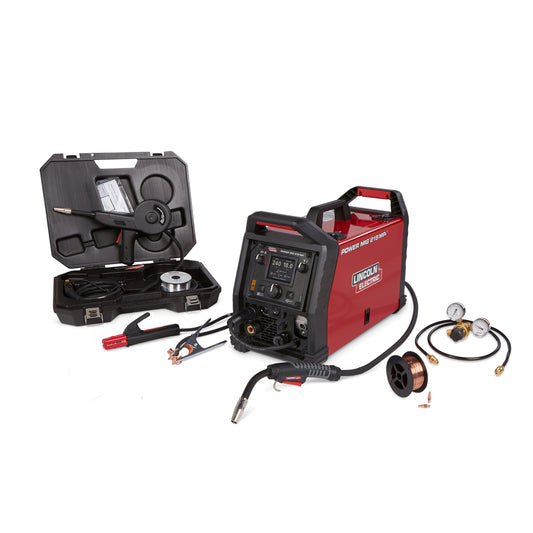Introduction
MIG welding is one of the most popular types of welding, probably because it’s easiest to get started and continue to learn. Whether you’re a beginner to the craft or you’re looking for a refresher on setting up your MIG welder, keep reading for an overview of the three components of your MIG welder’s settings: voltage, wire speed, and shielding gas.
Voltage
MIG welders use voltage to produce heat for the weld; other types of welders use amperage. Proper voltage is crucial for your welding project to succeed. MIG welding has one standard voltage and polarity type, unlike other welding. The voltage is D/C, meaning it flows in one direction (in this case, positive to negative). The polarity of a MIG welder is electrode positive – in other words, the handle is the positive side of the circuit. Electricity flows one way, from the machine to the handle.
Before using your machine, check to ensure that you’ve got the proper voltage for the project. The voltage determines the amount of heat the welding gun puts out, and the proper voltage plays a huge part in the success of your weld. Your MIG welder should come with a chart or table inside the wire panel; refer to this chart, bearing in mind the thickness of both the wire and the pieces you are welding, to determine the proper voltage. In general, thicker metals will require higher voltage, while thinner metals will require a low voltage.
NOTE: It’s critical to ensure that your ground clamp is firmly attached to the work, and that there is no paint, rust, grease, or anything else where the ground is attached. The area to be welded should also be thoroughly cleaned before welding. Otherwise, the weld will be sloppy and/or have a poor connection, and welding over the foreign substance may produce toxic fumes that are best avoided.
Wire Speed
The wire used in MIG welding can also be called the electrode. The type(s) of metal or metal alloys you are welding will determine the content and diameter of the wire to use. The wire speed (in conjunction with the voltage setting) determines the look and nature of the weld – in other words, the transfer type. In many cases, welders set the wire speed according to personal preferences for a specific transfer type.
How do you know if you have the proper wire setting? To get started, judge the weld you make (or have problems making). If the speed is too high for your voltage setting, the wire won’t melt, bonding won’t happen, and the wire will spool out of the gun – all clear indicators of this problem. If the wire speed is too low for the voltage, the wire will burn up before it contacts the metal, also making a weld unlikely and nearly sure to create a mess in the tip of your welding gun.
Shielding Gas
The gas(es) used in MIG welding shield the weld from the oxygen and carbon dioxide in the air. Oxygen and carbon dioxide aren’t inert gases, and removing them from the welding process makes MIG welding what it is – Metal Inert Gas welding. Once you’ve got the proper wire for your project, speak to someone in your local welding supply shop or refer to the wire packaging to determine the optimum mix of gases to use for your project. The types of shielding gases used impact the weld – how deep the penetration of the weld, what characteristics the welding arc has, even the mechanical properties of the joint.
To get started, set the gas between 25 and 30 CFH. Outdoor welding where windy conditions are likely will require higher output. Adjust it as necessary, keeping an eye on the weld. Too much gas pressure will cause problems around the weld, including discoloration and porosity.
Other Reminders
There are a few other things to check before turning on your welding machine. The inert gas gauge should be firmly attached to the bottle, and you should open the bottle slowly. The wire (electrode) should be fed properly through the dry rollers and run out the tip of the welding gun. You should also be sure to have the proper tip on the gun, and the tip should be completely clean, with the gas holes clear.
Conclusion
Welding is a skill to be learned, just like countless other skills. Continued practice and experience will make it easier and easier to determine your welding settings. Don’t get stuck working on the same projects with the same metals over and over, though, or you will not be a fully developed welder. Experiment with different alloys, thicknesses, and techniques to develop your knowledge of the craft.



